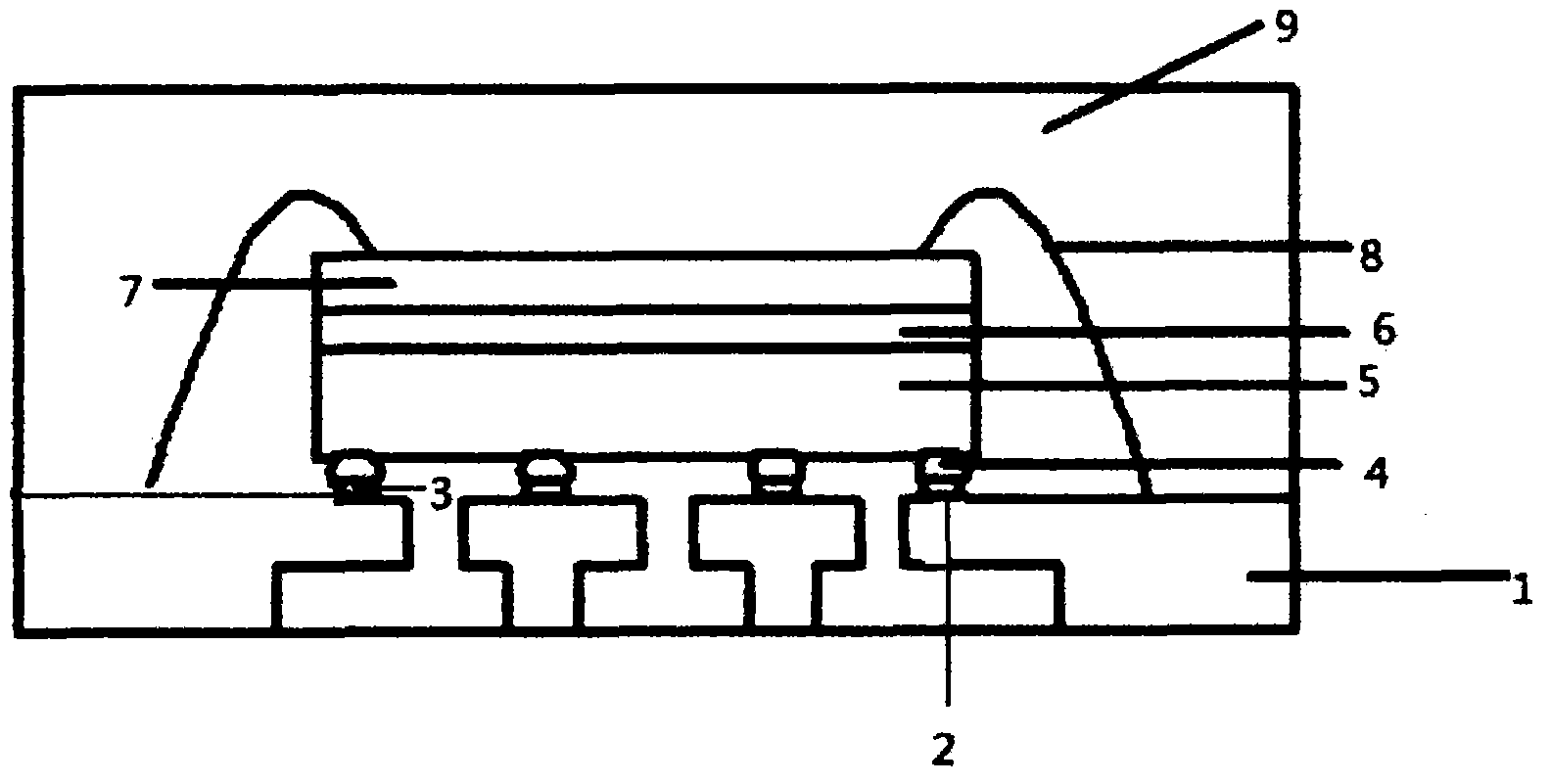Wafer level chip scale package (WLCSP) multiple chip stackable packaging piece and packaging method thereof
A stacked and packaged technology, which is applied in the direction of electrical components, semiconductor devices, and electrical solid devices, can solve the problems of high precision requirements for electroplating and photolithography, complicated WLCSP production process, and high cost.
- Summary
- Abstract
- Description
- Claims
- Application Information
AI Technical Summary
Problems solved by technology
Method used
Image
Examples
Embodiment 1
[0041] A packaging method of a WLCSP multi-chip stacked package can be carried out according to the following steps:
[0042] The first step, wafer thinning;
[0043] The thickness of wafer thinning is 50μm, and the roughness Ra is 0.10mm;
[0044] The second step is to plate metal bumps;
[0045] Plating 2um metal bumps 4 on the surface of metal Au in the chip nip area on the entire wafer;
[0046] The third step, scribing;
[0047] For wafers with a thickness below 150 μm, use a double-knife dicing machine and its process;
[0048] The fourth step is to tin-plate the corresponding area of the frame;
[0049] A layer of 2um tin layer is plated on the corresponding area of PAD on pin 1 in the frame;
[0050] The fifth step, on the core
[0051] When the chip is installed, the lower IC chip 7 is turned upside down, and the bumps of the chip are welded to the frame pins by using the Flip-Chip process; the upper IC chip 5 is bonded to the lower chip 7 with the adhesive ...
Embodiment 2
[0059] A packaging method of a WLCSP multi-chip stacked package can be carried out according to the following steps:
[0060] The first step, wafer thinning;
[0061] The thickness of wafer thinning is 130μm, and the roughness Ra is 0.20mm;
[0062] The second step is to plate metal bumps;
[0063] Plating 25um metal bumps 4 on the metal Cu surface of the chip nip area on the entire wafer;
[0064] The third step, scribing;
[0065] For wafers with a thickness below 150 μm, use a double-knife dicing machine and its process;
[0066] The fourth step is to tin-plate the corresponding area of the frame;
[0067] A layer of 25um tin layer is plated on the corresponding area of PAD on pin 1 in the frame;
[0068] The fifth step, on the core
[0069] When the chip is installed, the lower IC chip 7 is turned upside down, and the bumps of the chip are welded to the frame pins by using the Flip-Chip process; the upper IC chip 5 is bonded to the lower chip 7 with the adhesive 6;...
Embodiment 3
[0077] A packaging method of a WLCSP multi-chip stacked package can be carried out according to the following steps:
[0078] The first step, wafer thinning;
[0079] The thickness of wafer thinning is 200μm, and the roughness Ra is 0.30mm;
[0080] The second step is to plate metal bumps;
[0081] Plating 50um metal bumps 4 on the surface of metal Au or Cu in the chip nip area on the entire wafer;
[0082] The third step, scribing;
[0083] Wafers above 150μm adopt ordinary dicing process;
[0084] The fourth step is to tin-plate the corresponding area of the frame;
[0085] A layer of 50um tin layer is plated on the corresponding area of PAD on pin 1 in the frame;
[0086] The fifth step, on the core
[0087] When the chip is installed, the lower IC chip 7 is turned upside down, and the bumps of the chip are welded to the frame pins by using the Flip-Chip process; the upper IC chip 5 is bonded to the lower chip 7 with the adhesive 6;
[0088] The sixth step, reflo...
PUM
 Login to View More
Login to View More Abstract
Description
Claims
Application Information
 Login to View More
Login to View More - R&D
- Intellectual Property
- Life Sciences
- Materials
- Tech Scout
- Unparalleled Data Quality
- Higher Quality Content
- 60% Fewer Hallucinations
Browse by: Latest US Patents, China's latest patents, Technical Efficacy Thesaurus, Application Domain, Technology Topic, Popular Technical Reports.
© 2025 PatSnap. All rights reserved.Legal|Privacy policy|Modern Slavery Act Transparency Statement|Sitemap|About US| Contact US: help@patsnap.com

